|
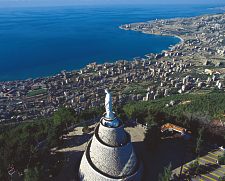
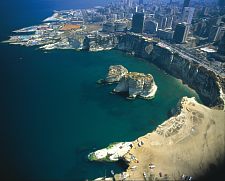
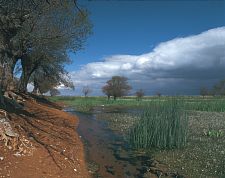
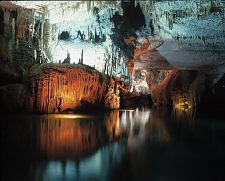

| |

We know they dominated sea trade in the
Mediterranean for 3,000 years.
Now DNA testing and recent archaeological finds are revealing just what the
Phoenician legacy meant to the ancient world—and to our own.
WHO WERE THE PHOENICIANS?
NEW CLUES FROM ANCIENT BONES AND MODERN BLOOD
by: Rick Gore,
National Geographic, 00279358, Oct 2004, Vol. 206, Issue 4
ANCESTRAL BLOOD
TESTING THE GENE POOL
Every day, long before dawn, the fishermen of Tyre, Lebanon, launch their boats
as their ancestors have done as far back as anyone can remember. By about nine
in the morning they return to port and relax over coffee and games of cards at a
seaside cafe. That's where Spencer Wells, a National Geographic emerging
explorer, and his colleague Pierre Zalloua, a geneticist at the American
University of Beirut, approached them about taking part in a wide-ranging
research project. The goal: to learn whether these fishermen are descended from
the Phoenicians who left the first traces of their lives here in the Levant more
than 5,000 years ago, and who later spread their culture westward by ship borne
commerce. The scientists could find the answer in the inherited-genetic patterns
of Y chromosomes if the fishermen agreed to donate samples of their blood.
Almost all volunteered eagerly--and then stood for portraits, some of which
appear here. "Most people are interested in their family history," says Wells.
"And they're fascinated by the idea that they have a secret in their blood that
not only ties them to their grandparents but to people they've never met."
The tests could confirm that men of Tyre-Christians and Muslims alike--are
related to the ancient traders. Wells and Zalloua also took samples in other
parts of the Phoenician world, where results may reveal the same lineage in
areas of former colonies like Sardinia and Malta.
MEN OF THE SEA
A LOST HISTORY
"I AM A PHOENICIAN," says the young man, giving the name of a people who
vanished from history 2,000 years ago. "At least I feel like I'm one of them. My
relatives have been fishermen and sailors here for centuries.
"Good, we can use some real Phoenicians," says Spencer Wells, an American
geneticist, who wraps the young man's arm in a tourniquet as they sit on the
veranda of a restaurant in Byblos, Lebanon, an ancient city of stone on the
Mediterranean. The young man, Pierre Abi Saad, has arrived late, eager to
participate in an experiment to shed new light on the mysterious Phoenicians. He
joins a group of volunteers --fishermen, shopkeepers, and taxi drivers--gathered
around tables under the restaurant awning. Wells, a lanky, 34-year-old
extrovert, has convinced Saad and the others to give him a sample of their
blood.
"What will it tell you?" Saad asks.
"Your blood contains DNA, which is like a history book," Wells replies. "Many
different people have come to Byblos over the centuries, and your blood carries
traces of their DNA. It's going to tell us something about your relationships
going back thousands of years."
Wells has no doubts about the power of the new genetic techniques he is bringing
to our understanding of ancient peoples. Nor does his bespectacled colleague
standing beside him on the veranda, Pierre Zalloua, a 37-year-old scientist with
a dark goatee and an intense passion for his Lebanese heritage. The two men hope
to find new clues to an age-old riddle: Who were the Phoenicians?
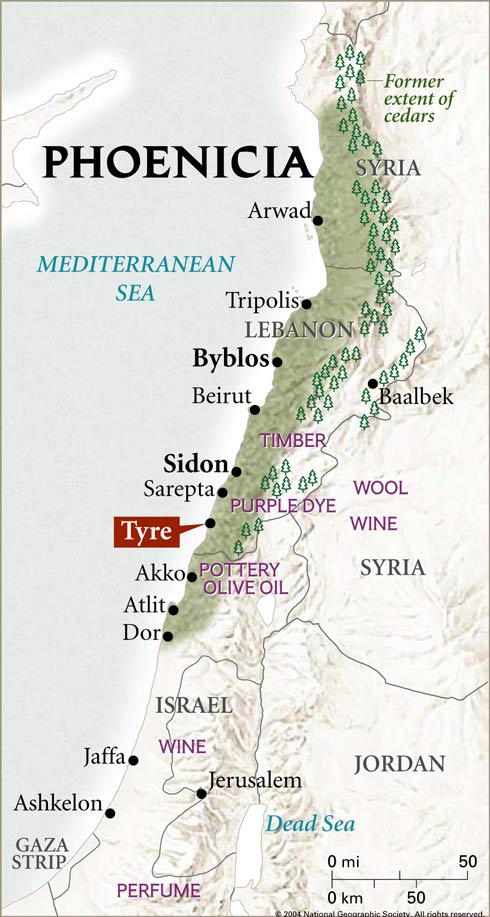 Although they're mentioned frequently in ancient texts as vigorous traders and
sailors, we know relatively little about these puzzling people. Historians refer
to them as Canaanites when talking about the culture before 1200 B.C. The Greeks
called them the phoinikes, which means the "red people"--a name that became
Phoenicians--after their word for a prized reddish purple cloth the Phoenicians
exported. But they would never have called themselves Phoenicians. Rather, they
were citizens of the ports from which they set sail, walled cities such as
Byblos, Sidon, and Tyre. Although they're mentioned frequently in ancient texts as vigorous traders and
sailors, we know relatively little about these puzzling people. Historians refer
to them as Canaanites when talking about the culture before 1200 B.C. The Greeks
called them the phoinikes, which means the "red people"--a name that became
Phoenicians--after their word for a prized reddish purple cloth the Phoenicians
exported. But they would never have called themselves Phoenicians. Rather, they
were citizens of the ports from which they set sail, walled cities such as
Byblos, Sidon, and Tyre.
The culture later known as Phoenician was flourishing as early as the third
millennium B.C. in the Levant, a coastal region now divided primarily between
Lebanon, Syria, and Israel. But it wasn't until around 1100 B.C., after a period
of general disorder and social collapse throughout the region, that they emerged
as a significant cultural and political force.
From the ninth to sixth centuries B.C. they dominated the Mediterranean Sea,
establishing emporiums and colonies from Cyprus in the east to the Aegean Sea,
Italy, North Africa, and Spain in the west. They grew rich trading precious
metals from abroad and products such as wine, olive oil, and most notably the
timber from the famous cedars of Lebanon, which forested the mountains that rise
steeply from the coast of their homeland.
The armies and peoples that eventually conquered the Phoenicians either
destroyed or built over their cities. Their writings, mostly on fragile papyrus,
disintegrated--so that we now know the Phoenicians mainly by the biased reports
of their enemies. Although the Phoenicians themselves reportedly had a rich
literature, it was totally lost in antiquity. That's ironic, because the
Phoenicians actually developed the modern alphabet and spread it through trade
to their ports of call.
Acting as cultural middlemen, the Phoenicians disseminated ideas, myths, and
knowledge from the powerful Assyrian and Babylonian worlds in what is now Syria
and Iraq to their contacts in the Aegean. Those ideas helped spark a cultural
revival in Greece, one which led to the Greeks' Golden Age and hence the birth
of Western civilization. The Phoenicians imported so much papyrus from Egypt
that the Greeks used their name for the first great Phoenician port, Byblos, to
refer to the ancient paper. The name Bible, or "the book," also derives from
Byblos.
Today, Spencer Wells says, "Phoenicians have become ghosts, a vanished
civilization." Now he and Zalloua hope to use a different alphabet, the
molecular letters of DNA, to exhume these ghosts.
The two geneticists became friends in 2000 at Harvard University. Wells was
pioneering genetic methods for tracing migrations of ancient peoples by looking
at the chromosomes of their living descendants; Zalloua was looking for ways to
use science to help heal his country, ravaged by 15 years of civil war between
its many religious factions.
Zalloua was particularly interested in understanding the genetic relationship
between the modern Lebanese and their Phoenician ancestors. During the bloody
civil war of the 1970s and 1980s, some groups used the name Phoenician as an
ideological weapon. Certain Maronites, the dominant Christian sect in Lebanon,
claimed a direct ancestry from the Phoenicians, implying that they held a more
legitimate historical claim on Lebanon than later immigrants from the Arabian
Peninsula. This inflamed many Muslims. The term Phoenician had turned into a
code word for Christian rather than Muslim.
It still is. "It's now become taboo to use 'Phoenician' here officially,"
Zalloua explains. "Go to the National Museum. You won't see the word anywhere.
They label everything simply by its age--early, middle, or late Bronze Age."
Could genetics show that modern Lebanese, both Christians and Muslims, share the
same Phoenician heritage? That's one question this project, funded by the
National Geographic Society, hopes to resolve. Wells and Zalloua have others.
For one, they want to know whether mysterious groups known as the Sea Peoples
might have migrated into Lebanon around 1200 B.C. and mixed with the Canaanites
to help create Phoenician culture. Although the Sea Peoples, who may have come
from the Aegean, marauded and burned most of the major cities along the coast of
the Levant, they apparently spared the Canaanite cities. One leading Phoenician
scholar, Maria Eugenia Aubet of Pompeu Fabra University in Barcelona, believes
the Canaanites made a deal with the Sea Peoples.
"I think they became friends," she says. "Phoenician material culture shows so
many elements from the Sea Peoples. The Phoenicians learned from them how to
build harbors, moorings, docks, and piers. The Sea Peoples, like the
Phoenicians, were excellent navigators--and they knew the routes west to the
rich sources of metals."
Spencer Wells suspects that the Sea Peoples also introduced their genes into the
DNA of the Canaanites.
"Was there a mass migration of Sea Peoples?" Wells asks, as he and Zalloua take
turns collecting DNA samples in Byblos. "Did it help create a Phoenician genetic
type? We have the tools now to answer those questions."
Wells and Zalloua are seeking markers--mutations that arose in Phoenician times
that can still be found in blood today. The markers would be extremely subtle,
changes in a few letters out of three billion in our book of genetic
instructions. But they would be enough to identify descendants of Phoenicians.
Markers can be found at specific places on the Y chromosome, the threadlike
package of genes located in the nucleus of almost every cell in males. Two
chromosomes, the X and the Y, determine sex. Females have two X's; males have
one X and one Y. The Y contains the genes that create maleness.
The Y chromosome, uniquely, is passed from father to son with no input from the
mother. Changes in its DNA are preserved generation after generation, so the
male descendants of Phoenicians would inherit ancient patterns of mutations
indefinitely.
Genetic analysis has traced all modern males back to a common Y-chromosome
ancestor, nicknamed Adam, who lived in Africa around 60,000 years ago and whose
descendants spread throughout the world. Lebanon has also seen many migrations
since Phoenician times, notably from the Arabian Peninsula during the rise of
Islam and from Europe during the Crusades.
"The genetic inputs from those migrations are very clear," says Zalloua,
including those of northern invaders. "There are villages in Lebanon that still
have a high percentage of fair-skinned blonds."
Identifying Phoenician markers takes sophisticated comparisons of the DNA from
thousands of men like those of Byblos. But Byblos is just one stop on Wells's
and Zalloua's sampling campaign--a campaign that will take many months to show
results.
Genetic researchers aren't the only ones seeking new clues to the identity of
the Phoenicians. Scientists from Lebanon to North Africa to Spain are finding
other evidence through traditional archaeology. Lebanese archaeologist Claude
Doumet-Serhal, for one, is leading a team systematically exploring for the first
time the port of Sidon, another major Phoenician city. The heart of that ancient
port lies beneath a thriving modern town, out of archaeology's reach until a
19th-century school was torn down. In 1998 Doumet-Serhal's team, funded by the
British Museum and a consortium of sponsors, began boring into the center of the
old city.
"We are part of a rebirth of archaeology in Lebanon after 15 years of civil
war," she says, descending into the excavation, which stretches for the length
of a football field amid a bazaar of old buildings. She moves excitedly through
the dig, a series of trenches where clusters of professional and student
archaeologists scrape, pick, and chisel back through 5,000 years.
The past three seasons have brought a bonanza of discoveries. She stops where
team members are scraping out the bones of a burial from the 20th century B.C.
This body, along with more than 30 others, was placed in an enigmatic layer of
sand as thick as four feet. The layer dates from shortly after 2000 B.C. Puzzled
by this deposit, Doumet-Serhal had the grains analyzed and found that they came
from a nearby dune.
"The ancient Sidonians sifted the sand and brought it here manually," she says.
"It's bizarre. They went to a lot of trouble to make this layer." Was this a
custom brought to Sidon by a wave of invaders? The evidence doesn't say. The
bodies initially placed in the layer were those of elite warriors. Their graves
were constructed with bricks and adorned with elegantly crafted weapons. Later
regular citizens, including children whose bodies were placed in clay pots, were
also buried in this layer.
Researchers studying the weapons of the warriors have gleaned important clues
from the metal. Analysis of isotopes indicates that the ores used to make the
weapons came from mines in modern Turkey, Cyprus, or Syria, evidence that the
Sidonians were already engaged in a flourishing metals trade in the eastern
Mediterranean by 1950 B.C.
Across the Mediterranean in Spain, the timbers of two seventh-century B.C.
Phoenician shipwrecks discovered in the Bay of Mazarron near Cartagena are
providing a different type of information--about how Phoenicians constructed
their ships. "For the first time we have the actual ships of the Phoenicians,"
says Ivan Negueruela of Spain's National Museum for Maritime Archaeology. "Their
ships are the key to their colonizing, the way they traveled the Mediterranean.
We can't understand them without their ships. Now we can see how they actually
cut the wood, how they joined it."
The ships reveal that the Phoenicians used mortise-and-tenon joints, giving
their boats more strength than earlier boats, which were basically made of
planks sewn together. The team discovered a wooden anchor that had been filled
with lead, apparently a novel invention of the Phoenicians. Researchers also
found intact Phoenician knots, amphorae the crew used to store trade goods, and
mills they used to grind wheat. The hulls of the boats were lined with brush,
the Phoenician version of bubble wrap, to keep their cargo of lead ingots from
shifting and damaging the hulls. That meant the Mazarron ships, measuring about
25 feet in length, were working boats, rather than the impressive galleys
historical sources say the Phoenicians sailed.
The Phoenicians may have used these smaller boats to ferry cargo to galleys
waiting offshore. The boats seemed too small to have made the open-sea journeys
back to Phoenician home ports. But Phoenician seafaring skills and larger
vessels let them travel into the Atlantic and trade along the African coast.
When did they first reach the Atlantic? Scholars debate the possibilities.
Classical texts suggest they had established a colony beyond the Strait of
Gibraltar at Cadiz by 1100 B.C., but no archaeological remains can be dated
earlier than the eighth century B.C. Spanish archaeologist Francisco Giles, a
veteran explorer of ancient ruins near the coast of Andalusia, thinks a painting
in a rock-shelter in the mountains overlooking the strait may answer the
question. The painting, discovered in a remote part of a cork tree forest,
stylistically dates to the end of the second millennium B.C. and portrays a
sailing ship surrounded by a group of stick figures.
"This represents contact," says Giles. "The local people were painting something
they had never seen before."
"The ships were most likely Phoenician, because it was the Phoenicians who
settled here," says his collaborator, Clive Finlayson of the Gibraltar Museum.
And settle the Phoenicians did. By the eighth century B.C. they had established
communities along the entire southern coast of Spain to reap the harvest of the
land and the riches of the Iberian mines.
"They created the concept of colonization,' says Giles. "They brought to the
Iberians all the products of cultures to the east. In return the Phoenicians got
the Iberians' natural resources."
The Phoenicians would have brought something else to Spain--their Y chromosomes.
Spencer Wells and Pierre Zalloua want to search for Phoenician markers in living
Spaniards. But to help them identify those markers, they are first taking blood
samples closer to the Phoenician homeland.
A steep hill known as the Byrsa rises along e Tunisian coast of North Africa,
overlooking the residences of modern Carthage, the most affluent suburb of
Tunis, the capital. In the distance peninsulas and promontories stretch into the
blue sea. On a sunny October morning Wells and Zalloua ascend the Byrsa and peer
down on the excavated streets of one of the earliest colonies, and certainly the
grandest, established by the Phoenicians.
Founded by the city of Tyre as early as 814 B.C., Carthage emerged as a
formidable power itself about 300 years later, after a 13-year siege by the
Babylonians depleted Tyre's resources. Eventually Carthage dominated the western
Mediterranean and gradually developed its own culture, known as Punic to the
Romans. As Rome emerged as a central Mediterranean power in the third century
B.C., it clashed with Carthage in a series of confrontations known as the Punic
Wars. The famous Carthaginian general Hannibal nearly conquered Rome, but in 202
B.C. he was defeated near Carthage. In 146 B.C. Rome burned and destroyed this
last major Phoenician city.
Wells and Zalloua have come to Carthage to seek help from Tunisian colleagues.
They need local DNA to find what's left of Phoenician chromosomes here. That's a
complex job: A lot of Middle Eastern people, as well as Africans and Romans,
have left their genes in Carthage over the centuries. Calculating when a
particular set of chromosomes emerged is difficult, but Wells and Zalloua say
they can date mutations relatively accurately.
Certain short sections of junk DNA, called microsatellites, mutate much more
rapidly than the longer sequences. They nevertheless mutate at a constant rate,
providing a clock that lets geneticists date how old a particular form of a
chromosome is. For example, Wells knows he comes from a western European
Y-chromosome type called M 173. Microsatellites indicate that the man who gave
rise to M173, and hence to most western Europeans, lived about 30,000 years ago.
Zalloua, on the other hand, has an M20 lineage, which originated in the area of
Iran around the same time and is mostly found today in India. Less than 2
percent of Lebanese men have that type.
Most Middle Eastern men belong to M89 and M172. M89s date back to a major
migration out of Africa around 45,000 years ago; M172s date back to the dawn of
agriculture about 12,000 years ago. Phoenician markers should be carried on
either of these types. Most men living in the area surrounding Carthage before
the Phoenicians arrived should probably have carried variations of the M96,
which is the aboriginal type in North and West Africa. So if Wells and Zalloua
find in Tunisia a significant number of M 172s and M89s, the Middle Eastern Y
chromosomes, that could suggest a link to the Phoenicians.
"If we can find markers here that could only have originated in the Middle East
during the Phoenician age, we can assume they were brought by the Phoenicians,"
says Wells.
While Wells and Zalluoa are taking samples in Tunisia, a Dutch archaeologist is
piecing together a different portrait of the Phoenician colonization at
Carthage. Roald Docter, a professor at Ghent University, is part of a
Tunisian-Belgian team that recently excavated the cemetery of the first
generation of Phoenicians to settle Carthage.
His site, like many archaeological digs, appears unspectacular at first glimpse.
Next to a supermarket in an urban zone, it is overgrown with weeds and pocked
with heaps of dirt, plastic bottles, and other trash. Last season's trenches
have slumped due to recent heavy rains.
"This looked very neat a month ago," he says, walking to the edge of a deep
muddy trench. He points to a round pit in the yellowish bedrock below. About
three feet across, it is one of nine his Tunisian colleagues have located. They
found pieces of funerary pots as well as fragments of bone--the bones of the
first settlers.
This site, called Bit Massouda, and an adjacent zone that Docter also helped
excavate with a University of Hamburg team, shows how the Phoenicians changed
and reorganized their colony as it grew into a city. During the first part of
the eighth century B.C. the homes were widely spaced along a dirt path, which
was later lined with cobbles. Then, as more settlers arrived, the city filled in
and became more densely urban. Remnants of elephant tusks indicate that merchant
shops were trading in ivory.
Around 675 B.C. another influx of Phoenicians surged into Carthage, bringing a
new style of four-room house typical of the Levant. Apparently, a growing menace
from the Assyrians had encouraged many Tyrians to emigrate from the homeland.
"If a group of Assyrian soldiers arrives every year, rapes your wife, and takes
your money, you might head west too," says Docter.
During this period the residents moved the original cemetery, replacing it with
a huge metalworking site. Docter's team has found remnants of a surprisingly
advanced technology. CT scans of ancient bellows reveal they contained intake
valves to regulate airflow into the hearths and raise the temperature of the hot
iron.
The Carthaginians were already strengthening their weapons with a metallurgical
technology similar to the Bessemer process, which was not developed until the
19th century. Metallurgist Hans Koens of the University of Amsterdam discovered
that the Carthaginians in antiquity were adding large amounts of calcium to the
metal, a process that chemically strengthens iron.
This past season Docter's research team located the source of that calcium--the
shells of the same mollusk, the murex, which yielded the purple dye that gave
the Phoenicians their name. Huge amounts of crushed shells, along with basalt
grinders and grindstones cover the metalworking site.
But at the end of the fifth century B.C. the metalworking region succumbed to
another population surge. As their city exploded in size, the residents built
houses over the hearths. The pits at Bir Massouda are revealing the foundations
of those homes. The residents by then belonged to a new society, as distinct
from its Phoenician founders as North Americans are today from their
17th-century colonial ancestors. They had embraced new variants of the Tyrian
gods. But the Carthaginians always retained a Phoenician style. They continued
their forefathers' wanderlust with voyages around Africa and perhaps farther.
Although the Carthaginians ruled the western Mediterranean for centuries,
ultimately they could not resist the power of Rome. Their final hours were
gruesome.
"Fire spread and carried everything down," wrote Appian, describing how Roman
soldiers finally breached the walls in 146 B.C. and torched the city, pulling
down its buildings on top of the residents hiding within.
Archaeologist Docter has found chilling evidence of that conflagration. He
points down at the mosaic floor of a house the team uncovered. A layer of black
char covers it.
"That's from the fires of 146 B.C." says Docter.
When Carthage fell, the people were enslaved and they disappeared, explains
Tunisian archaeologist Nejib Ben Lazreg. "This doesn't mean the culture
disappeared. It had become so rooted in North Africa that it was centuries
before people abandoned the language. By A.D. 193 Rome had an emperor from North
Africa, Septimius Severus, and he spoke with a strong Phoenician accent. That
was the revenge of Carthage."
The Phoenicians also persisted genetically. Early this year, as Wells and
Zalloua complete their DNA sampling, they shift their search from collecting
samples to analyzing the thousands of plastic vials of DNA they have assembled
at Zalloua's lab at the American University of Beirut.
"All this is concentrated DNA," says Zalloua, holding a box of vials from
Tunisia. He lifts out a vial labeled DN44. "We'll put a little of this on a
glass plate with appropriate enzymes to isolate a specific region of the
Y-chromosome DNA we want to analyze. We have lots of data to digest."
He prints a chart of their Lebanese data and runs his finger down a list of
analyzed samples. Most, but not all, samples indicate Middle Eastern or African
origins.
"Ah, there's a Spencer--a European," says Zalloua, pointing to an M173. "That
man might be descended from a crusader."
Over the next few months, the analysis of both Lebanese and Tunisian samples
proceeds. By the end of the summer, Wells and Zalloua have come to some
conclusions.
Who were the Phoenicians? The answer deciphered from their vials of DNA both
pleases and frustrates the scientists. Perhaps most significantly, their data
show that modern Lebanese people share a genetic identity going back thousands
of years.
"The Phoenicians were the Canaanites--and the ancestors of today's Lebanese,"
says Wells. That result extinguishes Wells' theory that the migrating Sea
Peoples interbred with the Canaanites to create the Phoenician culture.
"The Sea Peoples apparently had no significant genetic impact on populations in
the Levant," he explains. "The people living today along the coast where the Sea
Peoples would have interbred have very similar Y-chromosome patterns to those
living inland. They are basically all one people."
That result delights Zalloua; it supports his belief that both Muslim and
Christian Lebanese populations share an ancient genetic heritage.
"Maybe now we can finally put some of our internal struggles to rest," he says.
The data from Tunisia also help redefine the legacy of the Phoenicians.
"They left only a small impact in North Africa," Wells says. "No more than 20
percent of the men we sampled had Y chromosomes that originated in the Middle
East. Most carried the aboriginal North African M96 pattern."
That influx from the Middle East could have come in three waves: the arrival of
farming in North Africa 10,000 years ago, the Phoenicians, and the Islamic
expansion 1,300 years ago. Microsatellites will let the researchers estimate
when people bearing those markers arrived. Even if they all turned out to be of
Phoenician age, the impact on local people was relatively small.
"Apparently, they didn't interbreed much," Wells says. "They seem to have stuck
mostly to themselves" Since they left so few markers, Wells must modify his plan
to track Phoenician migrations around the Mediterranean--and perhaps even
farther.
"They were a slippery people," he says. "They came. They traded. They left. I
guess that only adds to their mystery."
And so--for the time being, at least--the Phoenicians remain glorious ghosts.
MERCHANT MARINERS
Rooted in the Canaanite culture of the eastern Mediterranean coast, the
Phoenicians became skillful traders and sailors whose colonies and ports of call
stretched to the Atlantic. They remained a loosely affiliated group of cities
dominated by powerful neighbors until Carthage finally forged an empire.
With mountains to their backs and the sea spreading before them, the Phoenicians
left a line of settlements along what is now the coast of Lebanon, Syria, and
Israel. Tyre, once the most powerful of their cities, possessed features that
Phoenician colonists sought again and again when settling on foreign shores: a
defensible island, a protected anchorage, and easy access to agricultural fields
on the mainland.
Sidon, another great port, provided evidence of a revolutionary Phoenician
development: the world's earliest alphabet. In the sixth century B.C. a king
named Tabnit obtained an Egyptian sarcophagus and added an inscription in
Phoenician so he could use it himself.
32OO B.C.
As early as the predynastic period, Egyptians imported prized cedars from
Phoenician traders of Byblos.
25OO B.C.
Major ports on the Phoenician coast--Byblos, Sidon, Tyre, and Beirut---emerged
as independent city-states.
1200 B.C.
A phonetic alphabet of 22 consonants developed, along with a distinct Phoenician
language and culture.
877 B.C.
Assyrian King Ashurnasirpal II visited the cities of Phoenicia, which soon began
to send gifts as tribute to his empire.
814 B.C.
Expanding westward, Tyre founded Carthage--Qart-hadasht, or "new city"--an early
Phoenician colony in Africa.
573 B.C.
After his predecessor defeated Assyria, King Nebuchadrezzar II of Babylonia
besieged and gained control of Tyre.
539 B.C.
Persian Emperor Cyrus the Great captured Babylon, and Phoenicia became a
province in his vast empire.
332 B.C.
Alexander the Great crushed Tyre, the only Phoenician city to offer serious
resistance to his conquest of Persia.
264 B.C.
The First Punic War began as Carthage and Rome fought for control of Sicily. A
second war started in 218 B.C. in Italy.
146 B.C.
Rome burned Carthage, ending the Third Punic War and annihilating the last major
center of Phoenician culture.
HOME PORTS
The Phoenicians exported their own raw material and crafts and transported goods
produced in other Mediterranean regions.
TRADE NETWORK
While searching in the Mediterranean--and beyond--for resources such as silver,
the Phoenicians found markets for their own products.
COLONIES
Ships on long trade expeditions laid over in western outposts. Settlers in North
Africa spoke a Phoenician dialect called Punic.
Bibliography:
Aubet, Maria Eugenia. The Phoenicians and the West: Politics, Colonies, and
Trade. 2nd ed. Cambridge University Press, 2001.
Edey, Maitland A. The Sea Traders. Time Inc., 1974.
Markoe, Glenn E. Peoples of the Past: Phoenicians. University of California
Press, 2002.
Moscati, Sabatino, ed. The Phoenicians. I. B. Tauris, 2001.
Moscati, Sabatino. The World of the Phoenicians. Orion Books Ltd., 1999. (Orig.
by Weidenfeld & Nicolson Ltd. 1968.)
Wells, Spencer. The Journey of Man: A Genetic Odyssey. Princeton University
Press, 2002.
|